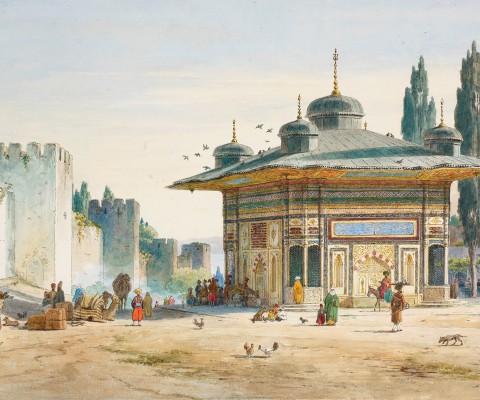Martinus Rørbye, Fountain of Sultan Ahmed III in front of the Imperial Gate in Istanbul, 1840
Martinus Rørbye was one the Danish Golden Age artists who travelled most. In 1835-36 he visited, amongst other places, Greece and Turkey together with the architect Gottlieb Bindesbøll, both of these destinations being quite new for Danish artists of the time. Rørbye kept a diary of his travels and also tells of the cold winter during which he stayed in Istanbul (the diaries are now kept in The Royal Library of Denmark). The large watercolour of the Fountain of Sultan Ahmed III, which was built in 1728 and stands just in front of the gateway to the royal palace, Topkapı, in Istanbul, was made some years later in 1840, with a view to being presented as a gift to the new king of Denmark, Christian VIII. Rørbye combined a number of figures from various places whom he had made sketches of on the same journey, and combined them in one composition, which the watercolour is a development of. Today some the sketches are found in the National Gallery of Denmark. The watercolour in The Queen’s Reference Library is a step on the way to the final composition, the large painting of the motif finished in 1846, which today hangs in ARoS Aarhus Art Museum.
Rørbye’s watercolour stems from a collection of drawings and watercolours by the leading Danish artists of the time. They are beautifully arranged in a red velvet box (probably after a sketch by the architect G. F. Hetsch, whose idea the gift was), and were given to the new king Christian VIII in 1840.
King Christian VIII was an important supporter of both the arts and sciences, not least during his time as Crown Prince. During the Golden Age he was the ‘praeses’ (a kind of chairman) of the Academy of Art, and was seen by many artists as a patron. When he became king in 1839, and not least when he was anointed in 1840, he received amongst other things a number of gifts from artists at the Academy of Art. Several of these are now to be found in The King’s Reference Library.
 Dansk
Dansk
 English
English
 Deutsch
Deutsch

